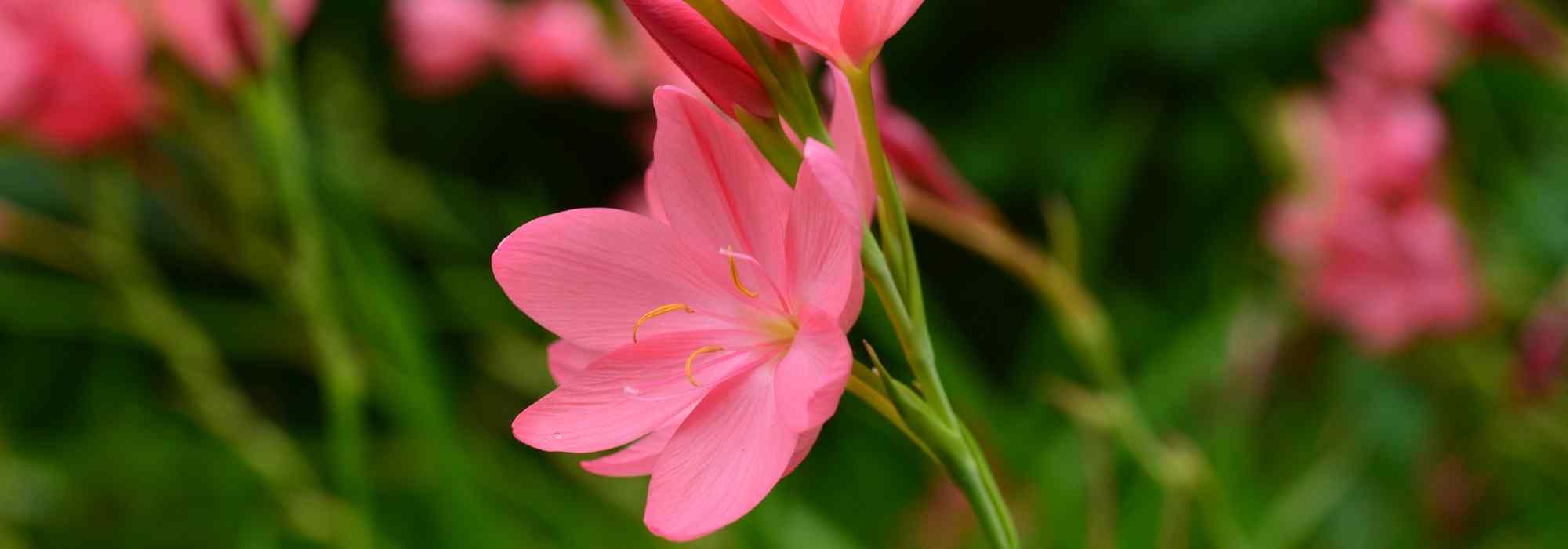
Schizostylis: planting, growing
Contents
Schizostylis in a nutshell
- Schizostylis coccinea is a vigorous perennial valued for its late and graceful flowering reminiscent of gladioli
- It flowers in spikes of star-shaped white, pink, or scarlet flowers
- It dislikes overly dry soils and prefers rich, cool, or even moist soils
- Quite hardy, it withstands winter well and slowly colonises space without requiring maintenance
- It is ideal for the edge of a bank or pond, as well as in a cool border
A word from our expert
Also known as kaffir Lily, the Schizostylis coccinea is an elegant perennial for moist soil, valued for its stunning late flowering with spikes adorned with star-shaped flowers resembling mini gladioli. Depending on the variety, it displays graceful bright scarlet flowers from late summer until the first frosts in Schizostylis coccinea ‘Major’, soft pink in Schizostylis coccinea ‘Mrs Hegarty’, or even white in Schizostylis coccinea ‘Alba’.
In mild winters, this somewhat tender plant will even retain its foliage.
Preferring damp locations, it thrives by the edges of a pond or water feature, in the cool areas of natural gardens. It forms fine clumps about 50 to 70 cm tall that spread widely over time. It can be grown in borders that remain cool in summer and even in pots that can be brought indoors in winter.
Easy to cultivate, hardy down to -10°C, it will accept any good garden soil as long as it does not dry out in summer.
Discover this beautiful groundcover perennial, closely related to Irises, perfect for damp gardens and pond edges!
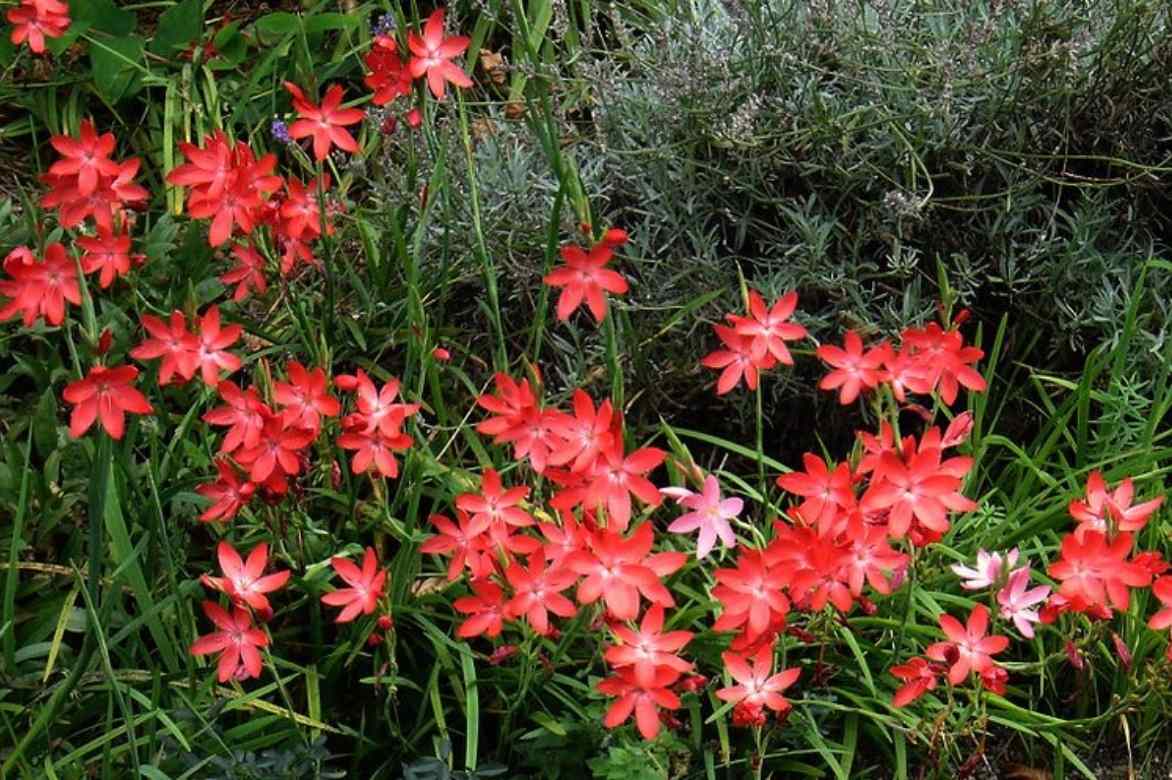
Schizostylis coccinea ‘Major’ (Photo: Peganum)
Description and botany
“`html
Botanical data
- Latin name Schizostylis coccinea
- Family Iridaceae
- Common name Kaffir Lily, Crimson flag lily, Scarlet gladiolus
- Flowering August to December
- Height 40-90 cm
- Exposure Sun
- Soil type rich and light, cool to moist
- Hardiness -10°C
Schizostylis, sometimes called Kaffir Lily, is a rhizomatous perennial from the Iridaceae family, just like irises, gladioli, and crocosmias. Native to South Africa, it grows spontaneously along waterways, in lagoons, and in wet meadows. The Schizostylis coccinea with its bright coral-red flowers (coccinea means “scarlet”) is the only representative of the genus. The type species has given rise to cultivars with white flowers, Schizostylis coccinea ‘Alba’, pink flowers, ‘Mrs Hegarty’, or red flowers ‘Major’.
With a vigorous and rapid growth, it forms an elegant herbaceous clump, slender, upright, and spreading, about 40 cm to 90 cm tall. Thanks to its suckering rootstock, it spreads through its swollen rhizomes at soil level, behaving like a groundcover. It eventually forms impressive clumps. The medium to dark green foliage is evergreen in mild climates, deciduous in cooler climates. It consists of fine, sword-shaped, ribbon-like leaves that arch gracefully. Linear, narrow, and tapered, they are arranged in a fan shape and marked by a prominent midrib.
In early autumn, branched flower spikes rise from the centre of the clump above the gramineous leaves. In its native habitat, it flowers in summer, but in our latitudes, it flowers later. From August until the first frosts, until December, or even beyond if the frosts are not too severe, flowers appear at the top of rigid and tall stems. This late flowering is perfectly timed in the garden when most plants have stopped blooming.
Each spike produces 4 to 15 small star-shaped flowers, approximately 2 to 5 cm in diameter. The cup-shaped flowers consist of 6 lanceolate petals and reveal long stamens. They are scarlet in the type species, hence its nickname “Scarlet Gladiolus”, pink, salmon, or white depending on the varieties. This stylised flowering is reminiscent of that of gladioli.
They make excellent cut flowers that last a long time in a vase.
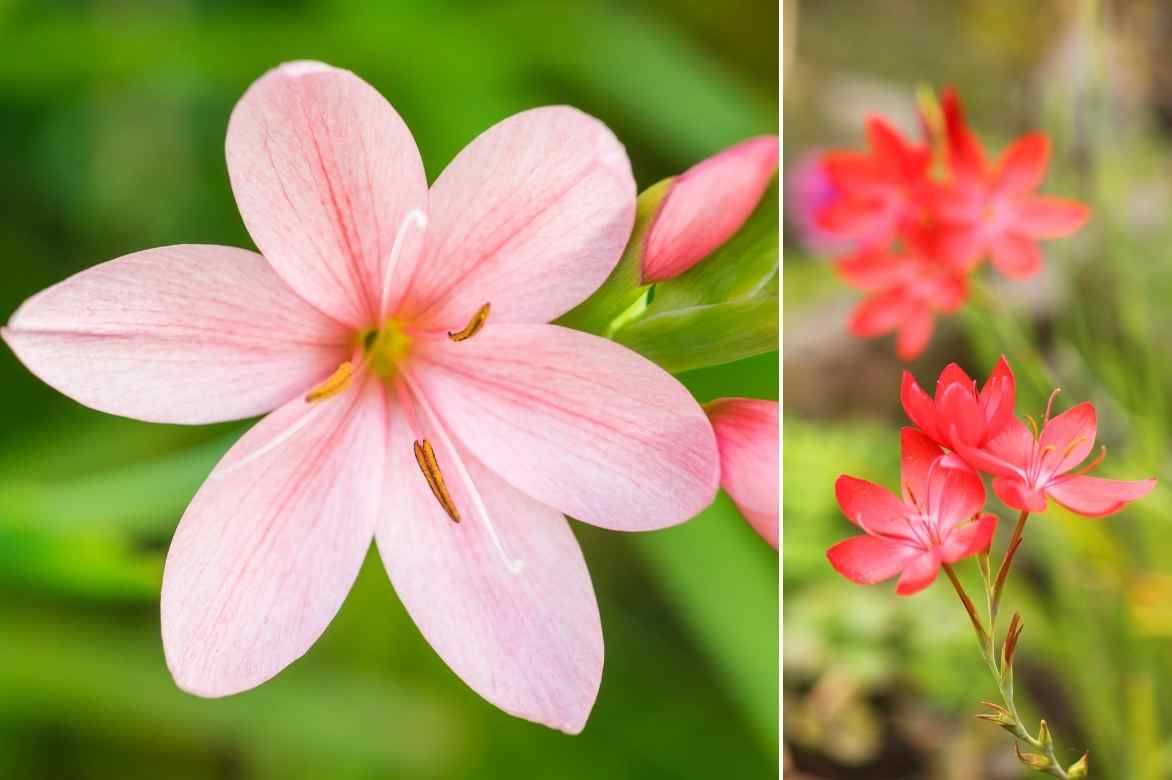
The pastel or more vibrant tones of Schizostylis allow for numerous combinations
“`
Read also
12 perennials for heavy, wet soilMain varieties
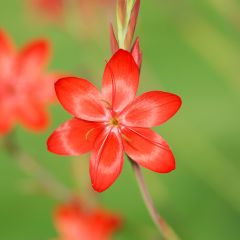
Schizostylis coccinea Major
- Flowering time September to November
- Height at maturity 40 cm
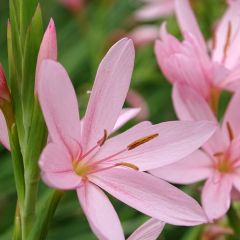
Schizostylis coccinea Mrs Hegarty
- Flowering time September to November
- Height at maturity 70 cm
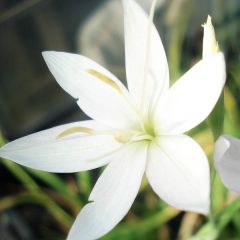
Schizostylis coccinea Alba
- Flowering time September to November
- Height at maturity 40 cm
Discover other Schizostylis
View all →Available in 0 sizes
Available in 1 sizes
Available in 2 sizes
Available in 1 sizes
Available in 2 sizes
Available in 1 sizes
Planting Schizostylis
Where to plant it?
Hardy down to -10°C, Schizostylis coccinea has a moderate resistance to cold, with a relative sensitivity stemming from its South African origins. Once well established, its rootstock can tolerate short frosts. It particularly enjoys regions with a mild climate, spared from severe cold, and sunny situations. It is best planted in full sun where it will be more floriferous and sheltered from cold winds.
Plant it in rich, light, moist, and well-drained soil. It also tolerates clay soils. It requires soil that remains cool in summer but not waterlogged in winter. It can adapt to ordinary soil, provided it is watered regularly in summer.
Think carefully about its location, as once established, it will spread over time.
It is ideal for adding elegance and character to a wild or contemporary garden in a mild climate and will find its place on the banks of a pond, around a water feature, to enhance a very damp area of the garden, or at the edge of a cool border. It can also be grown in pots on a terrace or by a swimming pool: it will need to be stored in a frost-free environment under a cold greenhouse. It will then bloom for a good part of the winter.
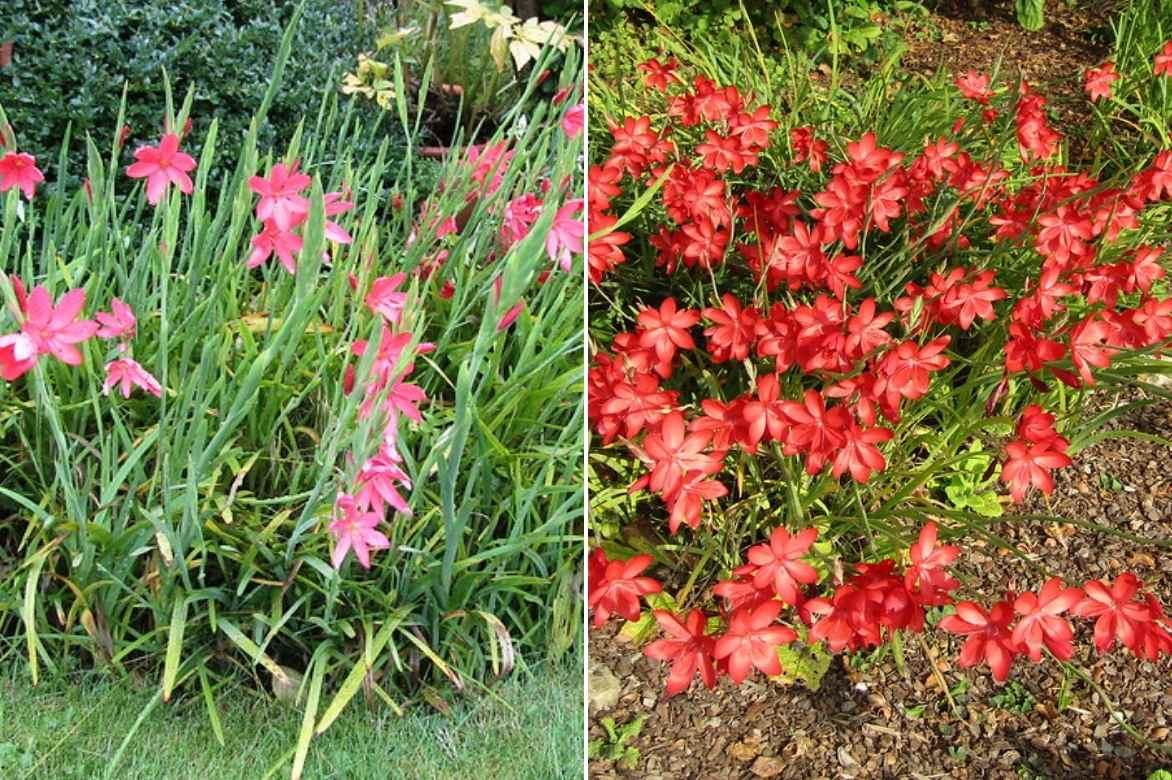
Schizostylis enjoys cool soils and bright exposure (Photos: L. Enking)
When to plant it?
The planting of Schizostylis coccinea is preferably done in spring between March and May after the last frosts, to allow the rhizomes to establish well before winter. However, planting is also possible in autumn if you live in a region with a mild climate where the risk of frost is low.
How to plant it?
In the ground
Opt for planting in small groups of 3 to 5 plants per m² for a beautiful colourful effect. Space them about 40 cm apart.
- Dig a hole wide and deep enough to accommodate the rhizomes
- Loosen the soil
- Barely bury the rhizomes (maximum 5 cm deep), so that they are just at the surface
- Cover them with just a few centimetres of a mixture of soil and compost
- Water
In a pot
Schizostylis coccinea is perfectly suited for pot cultivation, provided its requirements are met: constant moisture in summer!
- Lay a drainage layer at the bottom of a pot at least 50 cm deep
- Plant in a mixture of garden soil and compost
- Place the pot in full sun
- Water to ensure the substrate never dries out
Read also
Gardening in heavy, wet soilMaintenance and Care
Schizostylis is not very demanding: it only fears lack of water and frost! Ensure the soil remains cool to moist in summer. Water during dry spells or heatwaves. A little compost on the surface will help retain moisture in the substrate during the summer period.
Remove faded flowers to encourage the appearance of new ones.
In cold climates, after cutting back the clump, cover the stump with organic mulch in winter (dry ferns or fallen leaves).
In spring, tidy up the clumps by removing dry leaves and add one or two shovelfuls of compost on the surface; it is a fairly hungry plant that looks better in fertile soil.
Every 3-4 years, in spring, divide the clumps: tightly packed rootstocks are significantly less floriferous.
In pots, it must never lack water; ensure the soil does not dry out too much between waterings. During the growing season, support flowering with applications of liquid fertiliser specially formulated for flowering plants.
In cold regions, store the pot in a frost-free place in a greenhouse or unheated conservatory and reduce watering.
It is an easy plant that is resistant to insects and diseases.
Propagation
When conditions suit it, Schizostylis has a natural tendency to spread. It will also multiply very easily after three or four years by division of the stump, in spring during March-April.
- Lift the clump with a fork.
- Detach the rootstocks from one another to take 4 to 6 pieces.
- Replant these pieces without delay.
- Fill in by adding compost.
- Water generously and keep the soil moist to encourage recovery.
Pairing Schizostylis in the garden
The elegant flowering and light silhouette of the Schizostylis enhances the cool, moist areas of a garden, such as the edges of ponds, banks, or a cool border. It easily finds its place in a water garden alongside astilbes, carex, beard, or Arundo.
In borders, it will also make an impact when combined with knotweeds, lobelias, filipendulas, willowherbs, lysimachias, ligularias, Euphorbia palustris, and Hostas that, like it, appreciate soils that remain cool in summer.
The Schizostylis flowers until autumn, so take advantage of it to create an autumn border with red and pink hues, placing it near some asters, dahlias, Eupatorium, and Japanese anemones that will accompany its late flowering, along with persicarias and a few grasses like Chinese fountain grasses and miscanthus.
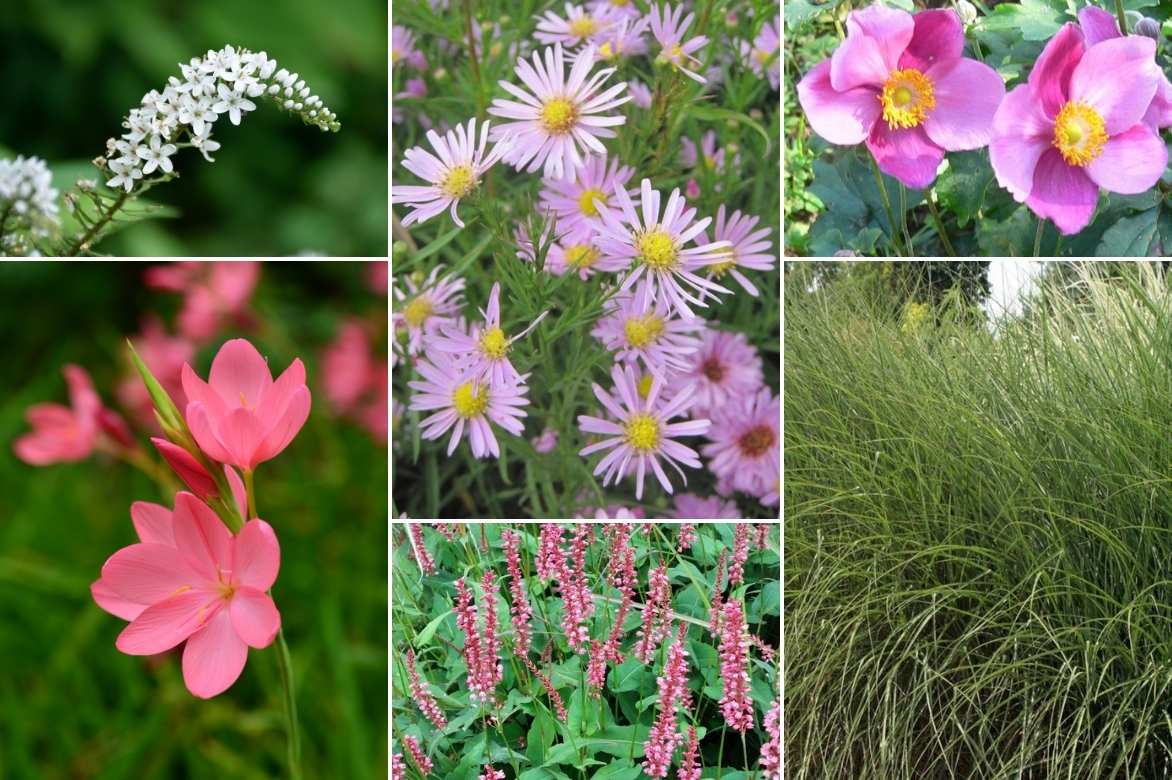
An example of an autumn-flowering border: Schizostylis, Lysimachias clethroides, Asters ‘Pink Star’, Persicaria amplexicaulis ‘Orange Field’, Japanese anemone hupehensis Splendens, Miscanthus sinensis Gnom
Useful resources
- Discover our perennial wetland plants to accompany it!
- Subscribe!
- Contents































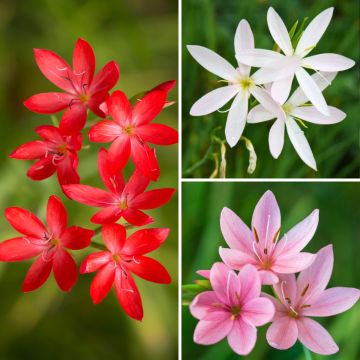
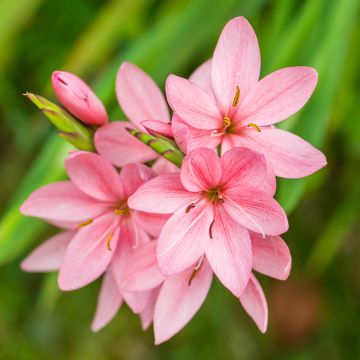



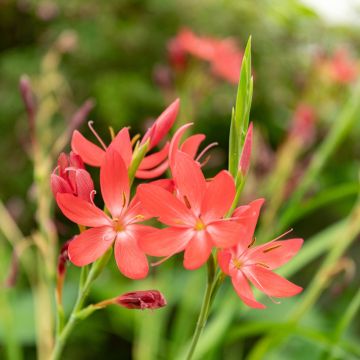
Comments